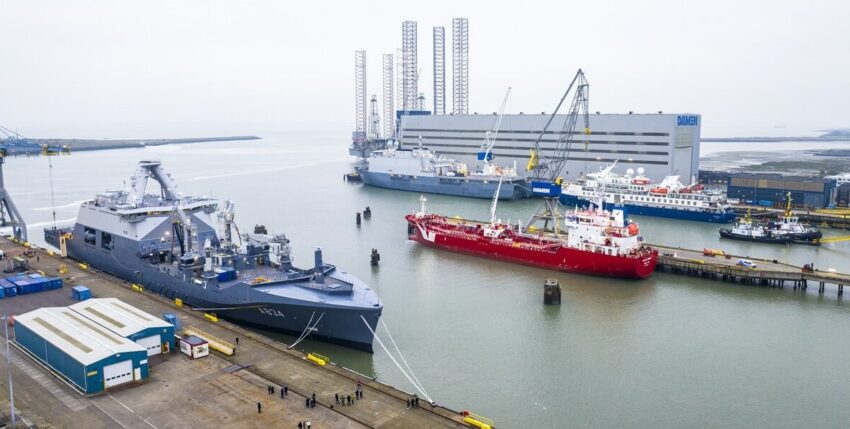The transfer of the future Royal Netherlands Navy task force supply ship "Den Helder" from Romania to the Netherlands was a risky endeavour in light of the war in Ukraine. The ship arrived in Vlissingen in the early morning of 13 December 2024 after leaving the Damen shipyard in Galati, Romania, on 16 November.

Sea trials and transfer
The transfer voyage was not only used for the transfer, but also for sea trials of the on-board systems. A replenishment at sea (RAS) manoeuvre with the "HNLMS Friesland" (P 842), an OPV of the Dutch Navy, was one of the final tests. Although no material or fluid transfer took place, the manoeuvre served as proof of the functional chain.
Final equipping phase
In the coming months, the "Den Helder" will undergo the final outfitting phase at Damen in Vlissingen-Oost. The christening is scheduled for February 2025. Under the direction of the Dutch Command for Material and IT (COMMIT), the weapon and command systems will be installed so that the ship can be handed over to the navy in 2026.

Technical data and capacities
The almost 180 metre long "Den Helder" replaces the supply ship "HNLMS Amsterdam", which was decommissioned in 2014. In addition to the "HNLMS Karel Doorman", the "Den Helder" will cover the Dutch Navy's need for a second task force supply vessel. The ship has extensive supply capabilities, including 7,600 m³ of diesel (F76), 1,000 m³ of helicopter fuel (F44), 226 m³ of drinking water and 434 tonnes of other goods including ammunition. It can accommodate two NH90 helicopters and has space for 20 containers. It also has a Role 2 medical capability and two 40-tonne cranes for material handling. In addition to a crew of 75, a further 75 people can be taken on board.

Courageous transfer with political implications
The transfer of the ship was particularly challenging in view of the war in Ukraine. The transfer was carried out with shipyard personnel, project managers from the Dutch procurement organisation and subcontractor personnel, tailored to the requirements of the various test and functional sections. Nevertheless, the ship was essentially steered by the naval crew, who were in control as in regular operations. On his website marineschepen.nl, Dutch naval journalist Jaime Karremann shows the COMMIT's project manager, Captain Joost Meesters, in uniform above the nameplate of the task force provider, which also bore its hull number A834 when it arrived in the Netherlands.
As the "Den Helder" was operating as a commissioned ship, it can be assumed that it passed through the Bosporus and the Dardanelles with the consent of the Turkish authorities. This puts the NATO partner in a better light than Ankara's behaviour in recent years had cast on the country (military operations in Syria, relations with Russia and China, blocking Finland and Sweden from joining NATO). However, it cannot be ruled out that compensation agreements between the Turkish government and Moscow played a role in the background.
Outlook
The first steel was cut for the "Den Helder" in December 2020 and the keel was laid in June 2021. "Exactly 48 months after the first steel was cut, the ship is now at the quay in Vlissingen for final work," Damen announced. This gives hope for the F126 frigate, which is being built by Damen Germany in cooperation with NVL.
Core data of the "HNLMS Den Helder" in comparison with the German Navy's Berlin-class task force supply ships. Note: at 20,900 tonnes, construction number 3, the "Bonn", has a higher displacement than its sister ships, a crew size that is 6 higher (which also includes medical personnel) and a different engine power.
| "Den Helder" | "Berlin" | |
| Dimensions (metres)
Length Width Draught |
179,3 26,4 8,3 |
174,0 24,0 7,4 |
| Displacement (tonnes) | 22.300 | 20.200 |
| Supply capacity
Fuels Solids/supplies incl. ammunition |
8,600 cubic metres 434 tonnes |
9,500 cubic metres 430 tonnes |
| Container sites | 20-24 | 78 - thereof 26 MERZ |
| Crew
Crew Embarkations |
75 75 |
161 72 |
| Helicopter | 2 NH90 | 2 NH90 |
| Drive | 2 x 7,900kW | 2 x 10,600 kW |
| Speed (knots) | 18+ | 20 |
--










